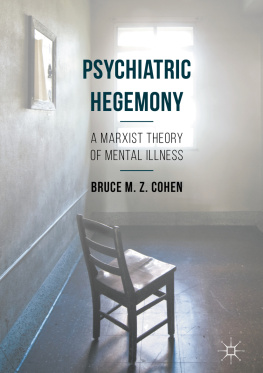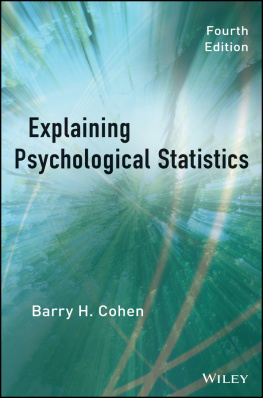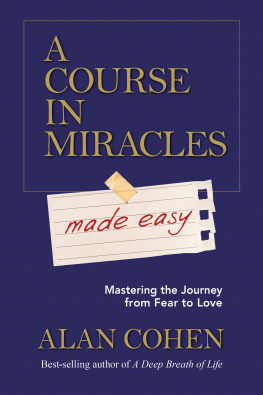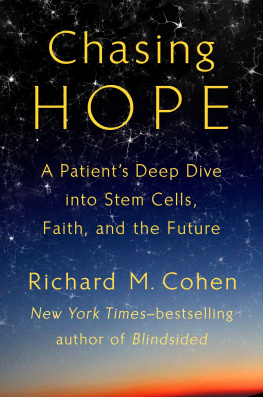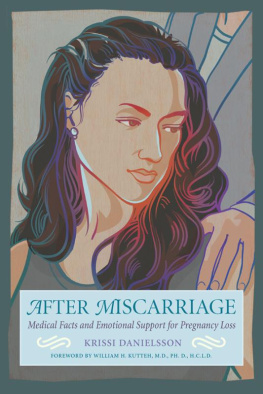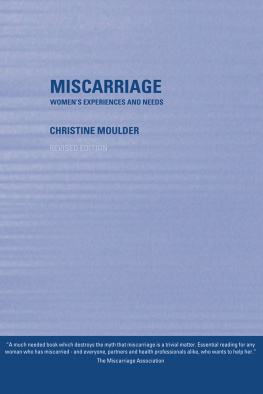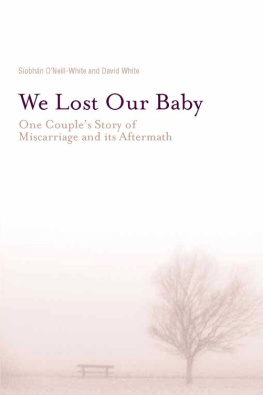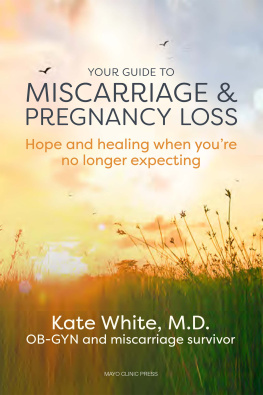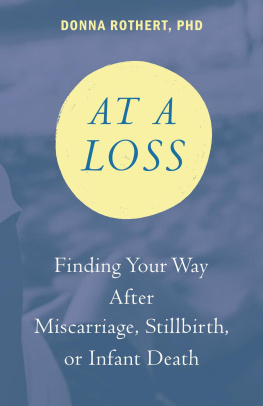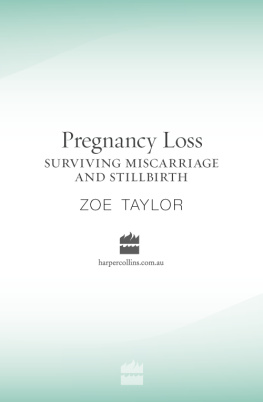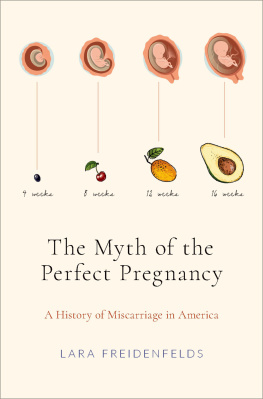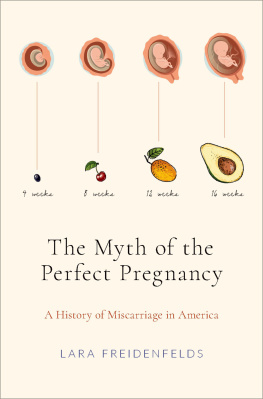HOUGHTON MIFFLIN COMPANY
BOSTON NEW YORK
2005
Copyright 2005 by Jon Cohen
ALL RIGHTS RESERVED
For information about permission to reproduce selections from this book,
write to Permissions, Houghton Mifflin Company, 215 Park Avenue South,
New York, New York 10003.
Visit our Web site: www.houghtonmifflinbooks.com.
Library of Congress Cataloging-in-Publication Data
Cohen, Jon, date.
Coming to term : uncovering the truth about miscarriage / Jon Cohen,
p. cm.
Includes index.
ISBN 0-618-27724-2
1. MiscarriagePopular works. I. Title.
RG 648. C 54 2005
618.3'92dc22 2004057676
Printed in the United States of America
Book design by Lisa Diercks
Typeset in Quadraat
QUM 10 9 8 7 6 5 4 3 2 1
THIS BOOK IS INTENDED TO PRESENT THE RESEARCH AND IDEAS OF
ITS AUTHOR ABOUT REPRODUCTIVE HEALTH ISSUES. IT IS NOT
INTENDED TO BE A SUBSTITUTE FOR CONSULTATION WITH A MEDICAL
PROFESSIONAL. THE AUTHOR AND PUBLISHER DISCLAIM
RESPONSIBILITY FOR ANY ADVERSE EFFECTS RESULTING DIRECTLY OR
INDIRECTLY FROM INFORMATION CONTAINED IN THIS BOOK.
For Ryan and Aidan
CONTENTS
Foreword by Sandra Ann Carson, M.D.
PART ONE: MOTHER NATURE
1: Not Viable
2: Through a Glass, Clearly
3: Scrambled Eggs
PART TWO: MYSTERIES
4: Rejection
5: Black Swans
6: The Cycle of Life
7: Really?
8: Anatomically Incorrect
PART THREE: HOPE
9: The Sky Isn't Falling
10: Expert Care
11: Miracle Babies
Acknowledgments
Notes
Glossary
Index
FOREWORD
"I FEEL AS IF I'VE CROSSED A DESERT AND THEN WAS GIVEN only a sip of water," explained one of my patients, who spontaneously lost her first pregnancy following eleven years of infertility treatment. More often, patients keep their emotions to themselves rather than state them so eloquently. Yet the feeling is surely universal among those who have experienced pregnancy loss. The phenomenon is not uncommon. Miscarriage occurs in 15 percent of clinically recognized pregnancies, and 3 to 4 percent of reproductive-age couples have recurrent losses. Despite these statistics, caring physicians can recount a trove of stories recited by surprised and upset patients. Yet few couples realize how many others are going through the same grief, longing, and bewilderment. Their sense of isolation makes the situation worse.
Jon Cohen, himself a parent of multiple miscarriages, is a master at describing the real-life emotional trauma inflicted by pregnancy loss. He details the initial surprise that accompanies a first loss and follows its evolution through the diagnostic dilemmas and therapeutic indecisions, to desperation, and finally acceptance. As a contributing correspondent for Science, he has chronicled subjects ranging from vaccines to the HIV/AIDS epidemic. He has written on the medical cost of poverty, thus showing both scientific as well as sociological prowess. His previous book, Shots in the Dark, was awarded the Science and Society Award of the National Association of Science Writers. Thus, it is not surprising that Coming to Term is well researched, lucidly presented, and generously but not ponderously referenced. Couples can rely on the accuracy of the information. This book will benefit all couples who are infertile, or who have had a miscarriage. It may be especially valuable to those trying to decide upon therapy after multiple miscarriages.
Coming to Term is divided into three parts, appropriately titled "Mother Nature," "Mysteries," and "Hope." In "Mother Nature," Cohen describes the reproductive system and its complexities in an elementary but non-condescending manner, clearly illustrating Mother Nature's most complex but perfectly designed system. Once he brings the process of normal reproduction to life for the reader, Cohen provides the information necessary for understanding the next section, "Mysteries." There he highlights the difficulties of studying reproductive disorders. Once again, Cohen interweaves his own experiences with those of investigators and their trials. He reminds us of difficulties that arose throughout history and have led to the predicament that physicians face when treating couples experiencing miscarriages.
In "Hope," Cohen describes couples facing the decision of whether to attempt untested therapy. At least half of all miscarriages cannot be prevented by empirical, hormonal, or immunological therapy. And this is probably for the better. Researchers have found that 50 percent of miscarriages are chromosomally abnormalsome studies suggest that the rate may even be as high as 70 percentand if those pregnancies continued to term, they would result in children who died shortly after birth or who survived with severe mental and physical problems. Nonetheless, these facts are difficult for couples to accept; they often hope that their pregnancy, regardless of the odds, was chromosomally normal. Because so many couples have shared their experiences with Cohen, the reader begins to understand why they would attempt therapy that is expensive, cumbersome, and probably ineffective. For example, carefully done studies have yet to show a clear benefit from therapy with intravenous immunoglobulinindeed, some studies have shown no benefit at allyet couples still try it in the hope that the "gold standard" of investigation that produced these results, the randomized clinical trial, was flawed and that perhaps for them the therapy will work. Couple after couple still attempts this futile course and other similar offerings. To his great credit, Cohen does not condemn or ridicule, but describes and asks the reader to understand the desperation and hope that leads these patients to conclude that, no matter what the evidence suggests, success will uniquely come to them. I am reminded of a Sesame Street skit in which Bert and Ernie are discussing why Ernie has a banana in his ear. When Ernie explains that the reason is to keep alligators away from Sesame Street, Bert retorts, "But there are no alligators on Sesame Street." Ernie replies, "See, it's working." In part because it is so hard to lose a baby, many believe therapy that has been proven ineffective is better than nothing. Indeed, it is their banana.
Cohen knows his subject intimately. He has read the pertinent investigations in the published medical literature and has even pursued the investigators. Throughout the book, he describes his interviews with the clinicians who study miscarriage. He presents the person behind the doctor. Their personalities percolate through the opinions that they share, clearly illuminating how even the shallowest of evidence is bolstered by the strength of their convictions. Readers feel as if they are experiencing an "office visit" with these individuals. These encounters are interesting not only for patients, but also for investigators and other physicians who will enjoy meeting their colleagues vicariously.
It is never easy to lose a babynot even when that baby is detectable only through biochemical means as a positive pregnancy test. Couples who experience repeated losses have their grief magnified by each loss and by the often conflicting advice of physicians. Frequently, well-meaning advice becomes menacing to couples searching for answers where no answer exists. Why have physicians and patients put up with such a plethora of unproven regimens? Why has miscarriage spawned so many dubious treatments? Why is such a thing tolerated, even by desperate patients?
The roots of this crisis can be found in a 1938 study by the British investigator Percy Malpas, who mathematically calculated the empirical risk of having a subsequent spontaneous abortion (the medical term for miscarriage) if couples experienced one, two, three, or more. The probability of having a fourth miscarriage was calculated to be over 90 percent. An American contemporary of Malpas, Nicholas Eastman, applied the equation to American women and calculated that they had a 95 percent chance of having a fourth spontaneous abortion. Because Eastman wrote a popular obstetrical textbook, his concept of "habitual abortion" became commonplace in obstetrics. Thus, decades of women were told that they were almost assured of having another miscarriage if they experienced three losses.
Next page

